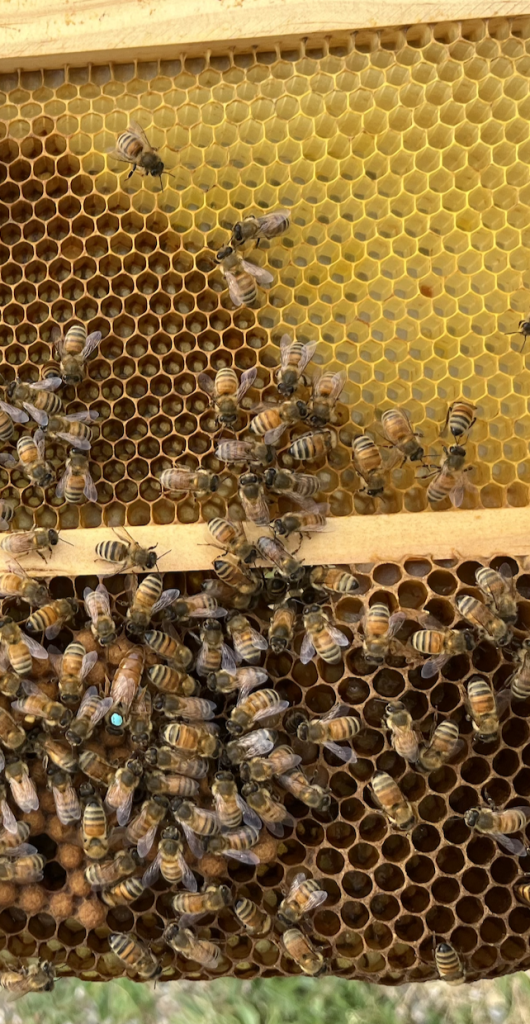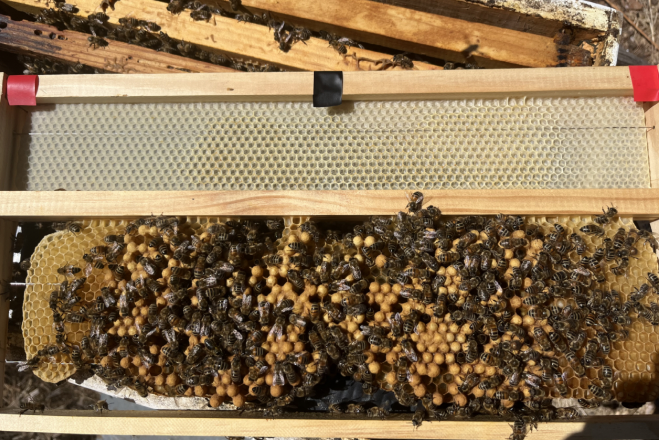
Alan Wade
Another mighty drone buster
The pestilent mite has arrived to stay and, while not quite here in the Australian Capital Territory and many parts of New South Wales, it has been creeping down the south coast and over the border into Victoria. So it is time to pull out all stops and check out what we can do to minimise the damage that the Pharaoh mite (Varroa destructor) will surely inflict.
What can we learn from the more successful efforts of overseas beekeepers similarly besieged by Varroa to swipe the mite. For hobby and sideline beekeepers we might learn most from the Europeans though the US Department of Agriculture and that ever persistent Californian Randy Oliver have much to offer. Many, particularly European, beekeepers there have abandoned the use of failing synthetic miticides and have turned to biotechnical means of control. They have also moved towards treating bees, best freed of brood, with natural products, a topic we will examine in Swipe the Mite Part II.
Here we focus on management, so-called biotechnical, techniques such as mite trapping as a means, if not entirely sufficient of itself, to keep the parasites in check. Since a fly swat will ever only keeps pest numbers down – it never eliminates them – we are reminded that the affliction of mites on our honey bees was not entirely of our making:
All things dull and ugly
All creatures short and squat
All things rude and nasty
The Lord God made the lot.
Monty Python (1980)
As outlined by Uzunov and Büchler, brood interruption methods: complete brood removal, trapping frame and queen caging are effective mite control strategiesi.
Caged frame techniques
The schemes designed by Büchler, Kovačić and Uzunov and trialled across Europe are largely premised on caging the queen for an extended period making the colony broodless. Mites that emerge and survive are exposed and can, if needed, be readily treated. There are many variants of the scheme, some that involve requeening after treatment and others that allow the queen to lay but involve removing brood comb with trapped mites once it is sealed. Such techniques are remarkably effective and, well practised, may circumvent the need for chemical treatment. This said, the schemes are labour intensive, require specialised gear – insertable queen cages or caged frames – and, to be most effective, should follow strict protocol and time scheduling. The techniques are simply outlined and well illustrated in the clear guide Summer brood interruption for vital honey bee coloniesii and detailed further in a series of European research publicationsiii.
The more extreme schemes involve either confining the queen to a small centrally located cage for a recommended twenty five days – where the colony will become broodless – or banding the queen in winter (literally preventing oviposition) to ensure there is a complete brood break. The latter specialised technique prevents mite reproduction at the low point in the annual cycle and is by no means risk free. Alternatively the queen is confined to a caged frame located centrally in the brood nest.
Once fully laid out this frame is cycled out of the cage, placed alongside established brood and replaced with a new frame. At the 9-10 day mark (the time from egg laying) phoretic mites are attracted en masse to that comb parasitising the developing bee pupae. Such mite laden sealed brood is then removed from the colony.
Short of mite invasion from nearby collapsing colonies, most mites emerging from brood will have been trapped reducing mite numbers to very low levels typically averting the need to treat. The queen will have been kept laying but all of one brood cycle will be sacrificed, an endeavour to radically remove latent mites.
The collective downsides of these scheme are those of a loss of a generation of young bees, the need to find the queen and the need to employ special queen caging gear. Combined with requeening or better re-celling, it will also be a very effective swarm control measure. Of course simply removing the queen and allowing the colony to raise its own will achieve the same end. It is of course possible to retain the queen but she will then need to be moved to a broodless nucleus colony and those bees treated. A reading of these European papers will provide a clear understanding of how each of the tropical honey bee species use a similar strategy (frequent swarming and absconding or migrating) to achieve a brood and hence also effect a mite brood raising break.
Open brood nest trapping techniques
While a rather less effective mite control measure, removal of sealed drone comb alone, loaded with Varroa, is a simple enough and can be practised with a modicum of effort. The advantage of this approach is that the queen does not need to be found and isolated and that she can continue her normal function of working with the colony to raise new bees. Since drone production is limited to colony spring buildup and summer, periods when they are most needed to mate with queens, drone comb removal is a seasonal measure that needs to be practised in conjunction with other controls such as autumn knockdown with an oxalic dribble or thymol treatment.
………………………………………………………………………………..
Bees in a hollow tree cavity – and in Warré and top bar hives – devote up to 20% of total comb area to drone cell construction. In practice bees also use drone cells for honey storage so the colony can fully regulate the number of drones it raises, restricted only by the numbers of drone brood cycles that can be achieved in the often very limited amount of drone comb and time available for drone raising. Westerham beekeepers focussed very much or raising Varroa tolerant bees and go so far as to suggest that allowing unrestricted drone production hardly influences honey production or the capacity of the colony to provide a pollination service.
………………………………………………………………………………..
Since Western Honey Bee worker brood, unlike Asian Honey Bee worker brood, is also a mite magnet, Varroa and Tropilaelaps control has proved to be a truly wicked problem: mites are attracted to worker larvae at the purple eyed larvae 8-9 days of age, those that are about to be sealed, so mites can be raised almost year round.
Mite-Brood Synchrony
As we have noted roaming mites and those clinging to adult bees enter cells of ready-to-be-sealed 9-10 day old drone larvae and 8-9 day old workers. Nevertheless mites have a strong (up to 10:1) preference for attachment to drone brood so it makes sense to promote drone raising and allow the bees to construct as much easily removable drone comb as possible. Natural beekeepers who do not use foundation can nevertheless reserve combs largely comprising drone cells rather than cutting those combs out. By routinely cycling out capped drone to the freezer they can achieve the same mite culling objective. After several cycles, such combs will achieve the robustness of regular Langstroth frames so are equally reusable.
In Langstroth frame beekeeping, providing space for bees to free-form comb generally results in the filling out of such space with comb comprised entirely of drone cells (Figure 1). Removing such drone comb once brood is sealed equates to removing slabs of mites.
In their Asian honey bee native host, Apis cerana, the mites only parasitise drone brood. They enter drone cells on days 8 and 9 so mite reproduction in Asian bees is strictly seasonal. Similarly we can conclude that Tropilaelaps mites will enter their giant honey bee native host drone cells, that is of Apis dorsata and Apis laboriosa, and Euvarroa mites will enter their dwarf native host Apis florea and Apis andreniformis drone cells just before they are sealed (see Table 1).

Figure 1 Worker comb in frame; larger free form drone comb below bottom bar. Note queen actively laying out drone cells.

Table 1 Brood cycling timetable for representative honey bee species.
Note that at least some African races of Apis mellifera complete their brood cycle about 1 1/2 days earlier, a factor severely limiting the parasitising effect of Varroa mites.
An attractive mite control measure, if not sufficient of itself, is to introduce a frame of drone comb and remove it just after all drone cells are sealed and certainly before drones (and mites) emerge at day 24. The alternative, finding and regularly uncapping all sealed drone comb in a working hive is clearly impractical.
Despite the regimen of having to open hives regularly the technique at least partially circumvents the need for chemical treatment, will be effective in reducing mite loads and will work in any colony actively raising drones. This leads us to the practicalities of setting up frames comprising mainly drone comb and timely removal of such combs once sealed.
Open brood nest drone comb brood trapping techniques
A simple strategy to remove destructive mites from honey bee colonies is to cycle out frames of mite-laden sealed drone brood on a strict timetable. The broodnest will continue to perform normally and mites will be preferentially trapped whenever maturing drone larvae are present.
However some mites will always enter worker brood while nurse bees will be continuously diverted to raising drone brood. Additional comb building resources will be needed (especially if drone comb is not recycled to the nest) so the queen will be distracted, in part, from her major role of laying worker eggs. Overall this approach will be less effective in removing mites than the caged frame technique, the tradeoff being that normal brood raising, while influenced, is not prevented.
Sacrificing old drone brood comb to the brazier and recycling well-formed drone comb – to give the queen a quick start – are no brainers. Two variants of the drone sacrifice scheme have gained currency:
Shallow frame scheme
Here a shallow or ideal frame filled out with worker foundation or drawn comb is inserted into the middle of the brood nest. That frame will be filled out with stores, while drone comb will be attached to the bottom bar. Once capped this free-formed sealed drone comb is then scraped off with a sharp hive tool and either sacrificed or made a welcome addition to the chook pen. Of course such comb must be removed on a strict three week cycle – drones and mites emerge together on day 24 – as drone pupae are a prime mite breeding ground.
Divided full depth frame scheme
The Randy Oliver improved drone comb removal scheme takes the cake for its simplicity and its minimal impact on normal brood nest functioningiv. A full depth frame divided into an upper honey storage zone and a lower drone comb section (Figure 2) takes advantage of the fact that bees have a natural proclivity to store honey and pollen above brood. The full depth frame scheme mimics the principle of the shallow frame technique, but confers the Langstroth advantage of comb frame rigidity and facility for recycling.

Figure 2 Drone mite trapping comb setup, 12 Lawrence Crescent Kambah ACT, 1 October 2024:
Top worker comb construction started: Bottom drone comb construction well in progress.
There are a few practical considerations to make this scheme work optimally:
- the top (2 1/2″ [65 mm]) section with worker comb foundation should be made to fit snugly;
- the underside of the divider needs a bead of wax or starter strip to encourage bees to draw drone comb;
- the bees may need to be fed heavily, in the absence of a flow, to encourage drone comb construction; and
- a good supply of spare frames will facilitate regular rotation out of mite laden drone brood.
A young and very productive queen will lay out the equivalent of a normal full depth worker comb frame in about three days in late spring. Under optimal conditions such drone comb will be drawn and laid our within a week and will comprise entirely capped brood comb by the middle of the third week. In practice inserting a second ‘drone frame’ after about 14 days and removing any inserted drone comb frame by no more than 21 days will optimise mite capture and removal.
Natural beekeeping
A wild colony will devote as much as 20% to brood nest area to building drone comb although initially an arriving swarm will construct mainly worker comb. Early in the season, a well established wild nest will avoid using drone comb for honey storage, in the process devoting as much effort as possible to raising drones for the ensuing swarming season. Synthesising the notions of both Hamiltonv and Seeleyvi, Johnson contends that colonies devote as many resources to raising drones as they do in preparing colonies to raise queens and swarmvii:
Interestingly, a honey bee colony has a 1:1 sex ratio between in investment in males and females, if you consider the full swarm to be the in the female sex, which males sense.
We may therefore conclude that any fairly strong colony with a broodnest comprising mainly worker comb, will jump at the opportunity to construct drone comb.
In top bar and Warré comb beekeeping we might ask how we might best use drone brood sacrifice to control mites. A basic tenet of natural beekeeping is that of free comb construction where finding naturally drawn drone comb is of common occurrence. Such frames, well marked, and once containing mainly sealed sealed drone cells can spend a night in the freezer and be returned to the centre of the broodnest and ideally cycled out on a regular, say three week, basis.
Will drone comb removal therapy work
Short of breeding bees that can outcompete mites, or allowing bees to collapse and rise like phoenix out of the ashes after treatment, there seem to be no single foolproof solutions to control of elusive Varroa and Tropilaelaps mites. In practice reliance on drone comb removal will not be enough especially late in the season when drones are no longer raised.
The holy grail of mite control is an Integrated Pest Management strategy, one that covers all bases in terms of mite removal and in situ mite treatment. Think monitoring and then either irradiating or burning all gear to control if not eliminate American Foulbrood. The need for a foolproof Varroa control scheme lies in breeding programs that will enable bees to manage the mites themselves, a scenario some time off in the Australian context.
In Smite the mite Part II we will focus on the role that natural miticides can play in control of the Varroa mite, paying particular attention to schemes that extends the impact of organic acids that are easy to apply.
Readings
iUzunov, A. and Büchler, R. (January 2018). Results from brood interruption studies in Kirchhain. Varroa control TF 2018 workshop 27th – 28th February 2018, Zadar, Croatia. https://www.researchgate.net/publication/323858740_results_from_brood_interruption_studies_in_kirchhain
iiUzunov, A., Gabel, M. and Büchler, R. (2023). Summer brood interruption for vital honey bee colonies: Towards sustainable Varroa control using biotechnical methods. Apoidea Press, Woodside Cottage, Dragons Lane, Shipley, West Sussex UK.
iiiBüchler, R., Uzunov, A., Kovačić, M., Prešern, J., Pietropaoli, M., Hatjina, F., Pavlov, B., Charistos, L., Formato, G., Galarza, E. and Gerula, D. (2020). Summer brood interruption as integrated management strategy for effective Varroa control in Europe. Journal of Apicultural Research 59(5):764-773. doi:10.1080/00218839.2020.1793278
Kovačić, M., Uzunov, A., Adjlane, N., Benko, V., Charistos, L., Dall’Olio, R., Formato, G., Freda, F., Hatjina, F., Kabakci, D., Malagnini, V., Pietropaoli, M., Puškadija, Z., Zoroka, V., Tiak Gajger, I., Ivgin Tunka, R., Villar, C. and Büchler, R. (2021). Queen caging with emphasis on honey production during summer: Preliminary results (CROSBI ID 715279). 17th COLOSS Conference (2021 COLOSS eConference) pp.31-31. https://www.croris.hr/crosbi/publikacija/prilog-skup/715279
Kovačić, M., Uzunov, A., Tlak Gajger, I., Pietropaoli, M., Soroker, V., Adjlane, N., Benko, V., Charistos, L., Dall’Olio, R., Formato, G. and Hatjina, F. (2023). Honey vs. mite: A trade-off strategy by applying summer brood interruption for Varroa destructor control in the Mediterranean Region. Insects 14(9):751. https://www.mdpi.com/2075-4450/14/9/751
Gabel, M., Scheiner, R. and Büchler, R. (2023). Immediate and long-term effects of induced brood interruptions on the reproductive success of Varroa destructor. Apidologie 54(2):20. https://link.springer.com/content/pdf/10.1007/s13592-023-00998-x.pdf
Uzunov, A., Chen, C., Gabel, M. and Kovačić, M. (2024). Queen ringing vs. queen caging for summer brood interruption. Journal of Apicultural Research 63(4):660-663. https://doi.org/10.1080/00218839.2024.2354087
ivOliver, R. (May 2007). IPM 5 Fighting Varroa: Biotechnical tactics Part 2: The one-two punch. Scientific Beekeeping. https://scientificbeekeeping.com/fighting-varroa-biotechnical-tactics-ii/#:~:text=The%20concept%20is%20simple%3A%20insert,frame%20before%20the%20mites%20emerge
Oliver, R. (May 2015). The learning curve – Part 3: The natural miticides. Scientific Beekeeping. https://scientificbeekeeping.com/the-learning-curve-part-3-the-natural-miticides/
vHamilton, W.D. (1975). Gamblers since life began: Barnacles, aphids, elms. Quarterly Review of Biology 50:17-52. https://www.journals.uchicago.edu/doi/epdf/10.1086/408439
viSeeley, T.D. (2019). The lives of bees: The untold story of bees in the wild. Princeton NJ: Princeton University Press.
viiJohnson, B.R. (2023). Honey Bee Biology. Princeton University Press, Chapter 8 Reproduction, p.151.
